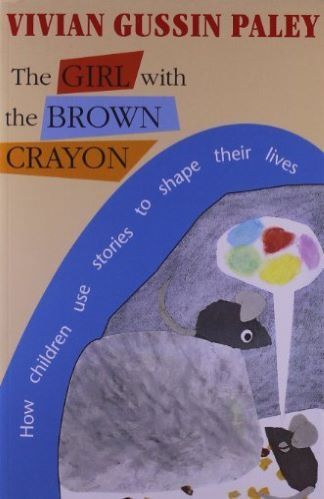
The Girl With The Brown Crayon
by Vivian Gussin Paley
Review by Trisha Lee
Trisha Lee is MakeBelieve Arts Artistic Director. She is also a writer, passionate about the role of story in children’s lives. For over twenty years, Vivian was her mentor and friend.
Book No: 9 – 1st published: 1997
To invent is to come alive. Even more than the unexamined classroom, I resist the univented classroom.
When I think about Vivian Gussin Paley’s books, or I’m asked to pick a favourite, it is always The Girl with the Brown Crayon that pops into my mind. It was in this book that Vivian gave me my first taste of the stories of Leo Lionni, a picture book author who is not so well known in the UK.
The book is set during Vivian’s final year in the classroom. There is a tinge of sadness each time this is mentioned and Vivian wonders if, like the character in the Leo Lionni story Mr. McMouse, she will be left with no name, when she no longer answers to the name of ‘teacher’.
The focus of The Girl with the Brown Crayon is Reeny, a five year old black girl, with a fondness for the colour brown, who falls in love with a brown mouse called Fredrick, the protagonist in one of Leo Lionni’s stories. Encouraged by Reeny’s passion, Vivian decides to spend her last year of teaching focusing predominantly on the books of this one author. She feels guilty about this decision. The other books shout, ‘what about us,’ but Vivian is decided.
Every couple of weeks, Vivian introduces a new Leo Lionni story to her class. They read the book, ‘almost to the point of memorising it,’ they act it out, they paint and discuss it and they compare the new characters they meet, with those they have met previously.
Vivian admits she finds the Leo Lionni story of Tico and the Golden Wings particularly difficult. Tico is born without wings, but his friends look after him. Then one night he wishes for a pair of golden wings so he can fly. When the wish is granted, Tico’s friends reject him. They will only make friends with him again when he gives away all his feathers and grows black ones in their place.
Fascinated to find out the children’s thoughts, Vivian asks them whether the characters in Tico’s story should have been kinder to each other. The children, particularly Reeny, help Vivian to think about the jealousy of the other birds in a different way.
For Reeny, Tico is not the martyr I have believed him to be. He is a perceptive friend who values the flock and emphasises with its feelings.
The Leo Lionni curriculum holds many surprises for Vivian. Through her discussions with the children and in part due to the perceptive nature of Reeny, Vivian discovered a central theme running through Leo Lionni’s words. ‘How will my friends react to the choices I make? Am I like Tico, or Frederick or Cornelius?’
As the year draws to a close, Vivian realises that in the same way as play encourages what she calls ‘Narrative Continuity,’ so does the work the children and her have been engaged in throughout the year, through their investigations into the stories of Leo Lionni. It was as if the stories provided a vehicle for the class to concentrate intensely over a long period of time, connecting images and dramatic events. As Vivian said to her co-teacher, Nisha Ruparel-Sen, at the end of a busy day, ‘It feels as though we are marching to that same rhythm, as in play… Now we are putting Leo Lionni to the test.’
Let’s face it, what school usually does is continually interrupt any attempt on the part of children to recapture the highly focused intensity of play. What we need to do is help them – and ourselves – get back on the track.’
With Leo Lionni, Vivian’s class rediscovers this intensity, exploring the human need to create and belong. In her final year of teaching, Vivian and the children develop their curriculum in the way it should be. One that has its starting point in the interests and passions of the children and that grows organically as the year progresses.











